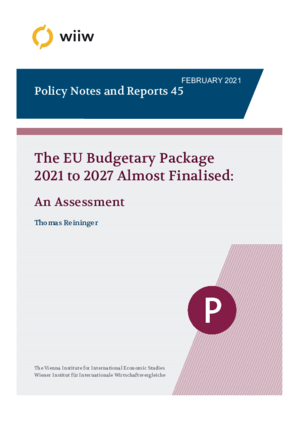The EU Budgetary Package 2021 to 2027 Almost Finalised: An Assessment
Thomas Reininger
wiiw Policy Note/Policy Report No. 45, February 2021
50 pages including 8 Tables and 3 Figures
This policy note presents an assessment of the EU budgetary package for 2021-2027, including the European Union Recovery Instrument ‘Next Generation EU’ (EURI-NGEU), with an introduction to the EU decision-making process and the state of play of the relevant legislation as well as an annexed overview of (a) revenue-side decisions, (b) the size, composition and allocation of expenditures and (c) the new rule-of-law regulation. Major achievements are complementary common EU borrowing for EURI-NGEU programmes and the increased focus on climate. However, the EU budget remains tiny, and a national fiscal and (common) monetary policy is needed for stabilisation. EURI-NGEU grants, which are particularly relevant for member states with below-average per-capita income, primarily target public investment in structural change aimed at climate-related and digitisation projects, but they may also help to finance COVID-induced national fiscal deficits, albeit only to a small extent. Governance will be the main challenge facing the implementation of these projects. Compared with the Commission’s proposal, the European Council cut funding for EU-wide strategic investments and for external action (neighbourhood, development, humanitarian aid), and, thus, the funds for external action even decline relative to 2014-2020 (EU27) in the midst of a global pandemic. Cuts to the proposed climate-specific Just Transition Fund undermine the 30% climate spending target, which also hinges on how direct agricultural payments are classified. Progress on the revenue side with the new plastic packaging waste-based national contribution and the roadmap to further new own resources contrasts with the expanded privilege of rebate on the GNI-based contribution for a few member states.
Keywords: European Union, Budget, Government expenditure, Policy design and consistency, Policy coordination, International Institutional Arrangements
JEL classification: E61, E62, F55, H50, H60, H61
Countries covered: EU Member States
Research Areas: Macroeconomic Analysis and Policy, Regional Development, Sectoral studies
